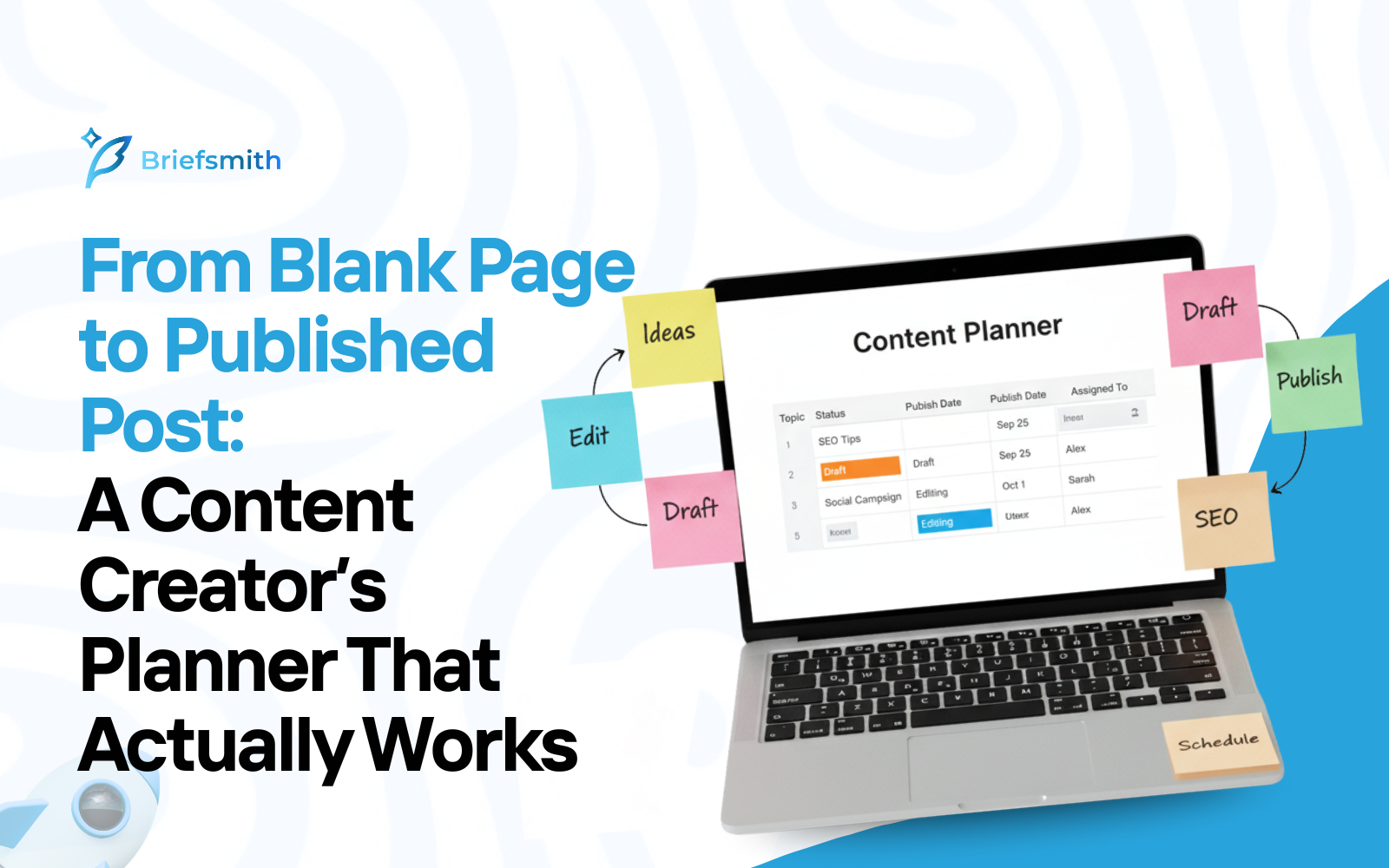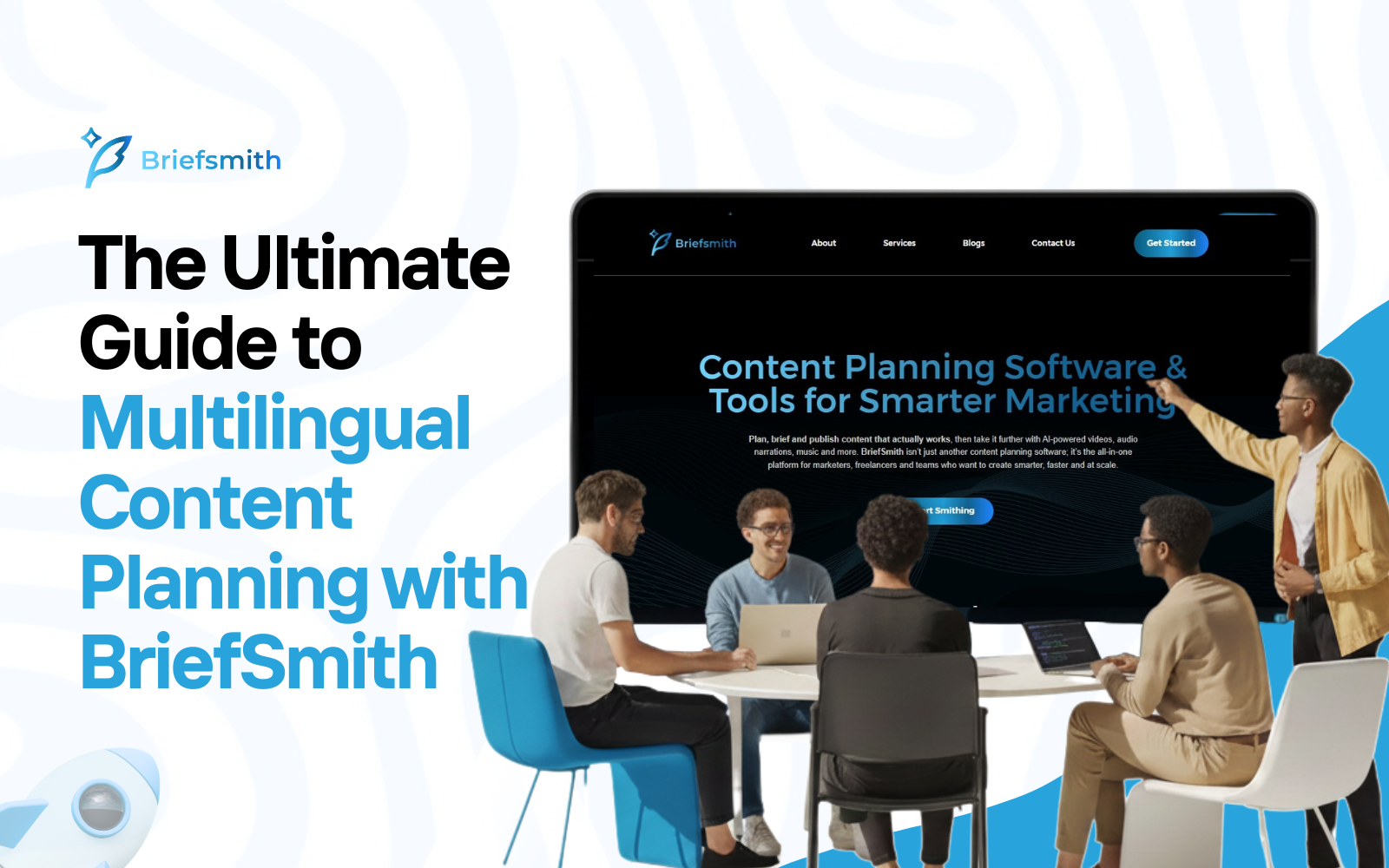From Blank Page to Published Post: A Content Creator’s Planner That Actually Works

The Blank Page Is Not the Problem, The System Is
If you’ve ever opened a new document, watched the cursor blink and wondered how on earth you’ll turn a vague idea into a publish-ready piece, welcome to the club. The “blank page” gets the blame, but the real issue is upstream: there’s no reliable system that turns sparks of ideas into finished, high-quality content on a schedule you can sustain.
A working content creator’s planner isn’t a pretty calendar template or a motivational quote. It’s a flow: capture ideas -> shape them into briefs -> move them through production -> publish -> distribute -> learn -> repeat. When that flow is visible, repeatable and lightweight, the blank page loses its power.
In this guide, you’ll build a practical planner that does exactly that. No corporate jargon. No unrealistic rituals. Just a system you can keep using next week, next month and next quarter.
For the bigger team context, read Why Content Planning Software Is the Secret Weapon for Modern Marketing Teams
Why Creators Stall (Even When They Have Good Ideas)
1) Ideas Are Scattered
Notebooks, browser tabs, DMs to yourself, voice memos, ideas exist, but none are where you need them when it’s time to write. A planner centralizes the chaos.
2) No Bridge From Topic to Outline
“I should write about X” is not a plan. Without a brief that turns a topic into structure, you’ll burn time on decisions that could have been made before the draft ever starts. See SEO Content Briefs: The Missing Link Between Strategy and Results.
3) Invisible Bottlenecks
Editing clashes with design. Approvals pile up. Publishing slips. If you can’t see the work, you can’t manage it.
4) Inconsistent Cadence
Publishing in bursts and going quiet in between confuses audiences and algorithms. Cadence beats intensity.
What a Real Planner Must Do (Beyond “Keep a Calendar”)
A creator’s planner that actually works should:
- Protect focus. Remove decision fatigue by front-loading choices in the brief.
- Enforce cadence. Make capacity and deadlines visible, so you publish steadily.
- Align with outcomes. Tie every piece to a goal: ranking, leads, nurture, or authority.
- Shorten time-to-first-draft. Turn research and structure into a repeatable template.
- Make collaboration boring. Clear roles, simple handoffs, no scavenger hunts for files.
- Close the loop. Measure what mattered, then feed the learning back into the next plan.
Curious how AI speeds up the front end? Read Content Marketing in 2025: How AI Brief Generators Are Changing the Game
The Seven Building Blocks of a Creator’s Planner
1) A Single Source of Truth
One home for ideas, briefs, drafts, assets, dates and status. If it isn’t in the planner, it doesn’t exist.
2) Idea Bank (Cold Storage + Hot Queue)
- Cold storage: raw sparks, no judgment.
- Hot queue: vetted ideas you intend to publish this cycle.
3) Brief Library (Templates You Actually Use)
A living template for posts, newsletters, videos and landing pages. Each brief includes keywords, audience, angle, structure and CTA.
4) Production Pipeline (Stage Gates)
Simple status columns: Idea -> Brief -> Draft -> Edit -> Design -> Ready -> Published -> Distributed. Add owner and due date. That’s it.
5) Asset Checklist
Images, charts, embeds, pull quotes, alt text, social snippets. When assets are standard, you stop reinventing the wheel.
6) Distribution Plan
Where each piece goes on Day 0, Day 3 and Day 10 (owned, earned and paid). “Hit publish and hope” is not a plan.
7) Review Cadence
A weekly stand-up and a monthly retro. What shipped? What slipped? What performed? What to change next cycle?
Step-by-Step: Build Your Planner From Scratch
Step 1: Define Outcomes and Capacity
Pick one primary outcome for the next 90 days: organic growth, qualified demo requests, or audience engagement. Then set capacity based on reality, not wishful thinking. If you can reliably produce two strong pieces per week, plan for one. Under-commit to over-deliver.
- Outcome example: “Rank top-3 for two mid-intent keywords and generate 30 qualified leads from content in 90 days.”
- Capacity example: “8 long-form posts + 4 newsletters + 2 downloadable assets per month.”
For a 90-day framework, see How to Build a Content Strategy That Doesn’t Fall Apart After 30 Days
Step 2: Centralize Your Ideas
Create two lists:
- Capture: anything goes. Headlines, questions from sales calls, reader comments, competitor gaps.
- Qualify: once a week, score ideas by potential impact, strategic fit and effort. Move the winners to your hot queue.
Pro tip: keep a running “Questions We Keep Answering” doc. Those are content seeds with built-in demand.
Step 3: Turn Ideas Into Briefs (Before You Write)
Every publishable idea gets a brief. Keep the template tight:
- Working headline and angle
- Primary + secondary keywords and search intent
- Reader (who, what they already know, what they need)
- Outline (H2/H3s, with bullets for coverage)
- Evidence plan (data points, examples, quotes)
- Internal links (which pages to support)
- CTA (what action should the reader take next)
This is where AI can save serious hours. A tool like BriefSmith can help you go from topic to SEO-aware outline in minutes, then you layer in your brand’s POV and proof. You stay the strategist; the machine handles the scaffolding.
Step 4: Schedule With Stage Gates, Not Just Due Dates
Put each piece on the calendar with stage dates, not only the publish date:
- Brief complete: T-10
- Draft due: T-6
- Edit complete: T-3
- Design assets ready: T-2
- Publish: T-0
- Distribution: T, T+3, T+10
If the brief misses T-10, you don’t push everything else back; you swap the slot with a ready piece. The cadence stays intact.
Step 5: Build the Asset Checklist Into the Flow
For each piece, check off:
- Feature image + alt text
- Inline charts/graphics
- Meta title/description
- Social copy (short + long variants)
- Snippet for newsletter
- Internal link insertions and anchor text
- UTM parameters for distribution
Make this a sub-task list inside the planner so the details don’t derail you during publish week.
Step 6: Publish and Distribute on a Schedule
Distribution should be predefined:
- Owned: site, newsletter, community forum, documentation.
- Earned: partners, influencers, curators, subreddit mods (where relevant).
- Paid (selectively): retargeting audiences with your strongest educational posts.
Create a simple post-publish cadence (e.g., same-day newsletter mention, 3-day follow-up social thread, 10-day roundup). Repurpose one strong insight into a short video or slide deck. You’re not spamming; you’re extracting full value.
Step 7: Review, Learn and Feed the Loop
Every week, ask:
- What shipped? What got stuck? Why?
- Which briefs saved time? Which need tweaks?
- Which assets performed above/below expectation?
Every month, look at:
- Rankings and impressions for target pages
- Assisted conversions/leads
- Time on page and scroll depth
- Internal link paths (are readers taking the next step?)
Take one learning into the next cycle: more depth on comparison pages, earlier proof in long-form, stronger CTAs on educational posts, etc.
A Simple, Reusable Brief Template (You Can Copy Today)
Working Title:
From Blank Page to Published Post: A Content Creator’s Planner That Actually Works
Primary Keyword: content creation planner
Supporting Keywords: content planning tools, content brief template, SEO content brief, content calendar
Reader & Intent:
In-house marketer or freelancer who needs a practical system to produce consistent, high-quality content and rank for strategic terms. Looking for actionable process; not theory.
Top-Level Outline:
- Problem/diagnosis (blank page is a systems issue)
- Core planner requirements (focus, cadence, outcomes)
- Seven building blocks
- Step-by-step setup
- Template + checklist
- Distribution cadences
- Review loop and metrics
- Next steps CTA
Evidence/Proof:
Screenshots or examples of stage gates, sample asset checklist, before/after timeline comparison.
Internal Links:
- SEO Content Briefs: The Missing Link Between Strategy and Results
- Content Planning Tools vs. Spreadsheets: What Saves You More Time?
- Content Marketing in 2025: How AI Brief Generators Are Changing the Game
CTA:
Plan the next 90 days and generate your first brief today.
How BriefSmith Fits (Lightly and Where It Helps Most)
You don’t need ten apps to run this system. The planner works best when planning and briefing live together. BriefSmith is built to do that: turn your vetted idea into an SEO-aware outline, store the brief where the team can find it and attach stage dates so production keeps moving. It won’t write your brand’s voice for you, that’s the human part, but it will erase hours of pre-draft wrangling and reduce missed steps at publish time.
If you’re still bouncing between a spreadsheet, a doc and a chat thread, merging those steps into one workspace is the fastest way to win back your week.
For a pragmatic compare-and-contrast, read Content Planning Tools vs. Spreadsheets: What Saves You More Time?
Common Pitfalls (And Practical Fixes)
Over-Ambitious Calendars
Publishing daily for two weeks then going dark helps no one. Plan for a cadence you can sustain for 90 days. If you’re unsure, pick the lower number.
“We’ll Figure It Out in Draft”
You won’t. You’ll figure it out in the brief or you’ll figure it out late. Push decisions upstream.
Trend Chasing Without Strategy
Trends can work, but only when they map to reader problems and your business outcomes. Use your idea bank to park trends; only promote them to the hot queue if they serve the goal.
Skipping Distribution
If distribution isn’t on the checklist, it won’t happen. Treat it as part of the piece, not an afterthought.
Measuring Everything, Learning Nothing
Pick a few lead indicators (publish cadence, time-to-first-draft, completion rate) and a few lag indicators (qualified leads, assisted conversions, rankings for target terms). Review monthly. Adjust one variable at a time.
Sample Week in a Planner That Works
- Monday: Qualify three ideas. Promote one to hot queue. Generate and refine the brief.
- Tuesday: Draft Piece A using brief. Request assets with the checklist.
- Wednesday: Edit Piece A. Insert internal links. Prepare meta and social snippets.
- Thursday: Publish Piece A. Execute Day-0 distribution. Start draft of Piece B.
- Friday: Review metrics from last month’s top post. Update brief template with a new FAQ section that drove engagement.
That’s not glamorous. It’s dependable. Dependable scales.
Final Thoughts: Make the System Do the Heavy Lifting
The blank page doesn’t beat disciplined creators; chaotic systems do. A creator’s planner that actually works replaces chaos with a clear path from spark to shipped. Ideas land in one place. Briefs make decisions early. Stage gates protect cadence. Assets are predictable. Distribution is planned. Reviews are routine.
Start simple. Centralize ideas. Brief before you draft. Schedule stage gates. Close the loop. If you want help compressing the slowest parts, research and outline, use a tool like BriefSmith to generate a strong first pass, then add your expertise and evidence.
When you make the process boring, the work gets better. And better work, shipped consistently, is what moves the needle.



